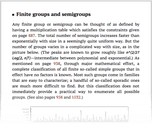Notes
Chapter 5: Two Dimensions and Beyond
Section 1: Introduction https://www.wolframscience.com/nks/chap-5--two-dimensions-and-beyond--notes#sect-5-1--introduction
https://www.wolframscience.com/nks/chap-5--two-dimensions-and-beyond--notes#sect-5-1--introduction
Section 2: Cellular Automata https://www.wolframscience.com/nks/chap-5--two-dimensions-and-beyond--notes#sect-5-2--cellular-automata
https://www.wolframscience.com/nks/chap-5--two-dimensions-and-beyond--notes#sect-5-2--cellular-automata
Implementation [of 2D cellular automata]
General rules [for multidimensional cellular automata]
Numbers of possible [2D cellular automaton] rules
Symmetric 5-neighbor [2D cellular automaton] rules
Growth [2D cellular automaton] rules
History [of 2D cellular automata]
Limiting shapes [in 2D cellular automata]
Projections from 3D [cellular automata]
Section 3: Turing Machines https://www.wolframscience.com/nks/chap-5--two-dimensions-and-beyond--notes#sect-5-3--turing-machines
https://www.wolframscience.com/nks/chap-5--two-dimensions-and-beyond--notes#sect-5-3--turing-machines
Implementation [of 2D Turing machines]
History [of 2D Turing machines]
Visualization [of 2D Turing machines]
Section 4: Substitution Systems and Fractals https://www.wolframscience.com/nks/chap-5--two-dimensions-and-beyond--notes#sect-5-4--substitution-systems-and-fractals
https://www.wolframscience.com/nks/chap-5--two-dimensions-and-beyond--notes#sect-5-4--substitution-systems-and-fractals
Implementation [of 2D substitution systems]
Connection [of 2D substitution systems] with digit sequences
[2D substitution systems with] non-white backgrounds
Higher-dimensional generalizations [of substitution systems]
[Substitution systems based on] other shapes
Implementation [of geometric substitution systems]
Connection [of geometric substitution systems] with digit sequences
Visualization [of geometric substitution systems]
Section 5: Network Systems https://www.wolframscience.com/nks/chap-5--two-dimensions-and-beyond--notes#sect-5-5--network-systems
https://www.wolframscience.com/nks/chap-5--two-dimensions-and-beyond--notes#sect-5-5--network-systems
Implementation [of network systems]
Rule structure [for network systems]
[Systems based on] undirected networks
Computer science [and network systems]
Properties [of network systems]
Section 6: Multiway Systems https://www.wolframscience.com/nks/chap-5--two-dimensions-and-beyond--notes#sect-5-6--multiway-systems
https://www.wolframscience.com/nks/chap-5--two-dimensions-and-beyond--notes#sect-5-6--multiway-systems
Implementation [of multiway systems]
General properties [of multiway systems]
Properties [of multiway system example]
Frequency of behavior [in multiway systems]
Semigroups and groups [and multiway systems]
Formal languages [and multiway systems]
Multidimensional multiway systems
Limited size versions [of multiway systems]
Section 7: Systems Based on Constraints https://www.wolframscience.com/nks/chap-5--two-dimensions-and-beyond--notes#sect-5-7--systems-based-on-constraints
https://www.wolframscience.com/nks/chap-5--two-dimensions-and-beyond--notes#sect-5-7--systems-based-on-constraints
The notion of equations [versus constraints]
Explanations based on constraints
1D [systems based on] constraints
[Excluded blocks in] dynamical systems theory
2D [systems based on] constraints
Numbering scheme [for 2D constraints]
Identifying the 171 patterns [that satisfy 2D constraints]
Checking [tilings with] constraints
Representing repetitive [2D] patterns
Searching for patterns [that satisfy constraints]
Undecidability [for 2D constraints]
NP completeness [for 2D constraints]
Non-periodic pattern [forced by 2D constraint]
Other types of [2D] constraints
Relation to 2D cellular automata
Relation to 1D cellular automata
Correspondence systems [as constraints]
Formal languages [and constraints]


![Implementation [of 2D cellular automata] Implementation [of 2D cellular automata]](/nks/img/thumbnails/notes-5-2--implementation-of-2d-cellular-automata--textonly.png)
![General rules [for multidimensional cellular automata] General rules [for multidimensional cellular automata]](/nks/img/thumbnails/notes-5-2--general-rules-for-multidimensional-cellular-automata--textonly.png)
![Numbers of possible [2D cellular automaton] rules Numbers of possible [2D cellular automaton] rules](/nks/img/thumbnails/notes-5-2--numbers-of-possible-2d-cellular-automaton-rules--textonly.png)
![Symmetric 5-neighbor [2D cellular automaton] rules Symmetric 5-neighbor [2D cellular automaton] rules](/nks/img/thumbnails/notes-5-2--symmetric-5-neighbor-2d-cellular-automaton-rules--textonly.png)
![Growth [2D cellular automaton] rules Growth [2D cellular automaton] rules](/nks/img/thumbnails/notes-5-2--growth-2d-cellular-automaton-rules--textonly.png)

![History [of 2D cellular automata] History [of 2D cellular automata]](/nks/img/thumbnails/notes-5-2--history-of-2d-cellular-automata--textonly.png)

![Limiting shapes [in 2D cellular automata] Limiting shapes [in 2D cellular automata]](/nks/img/thumbnails/notes-5-2--limiting-shapes-in-2d-cellular-automata--textonly.png)



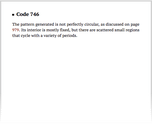

![Projections from 3D [cellular automata] Projections from 3D [cellular automata]](/nks/img/thumbnails/notes-5-2--projections-from-3d-cellular-automata--textonly.png)
![Other geometries [for cellular automata] Other geometries [for cellular automata]](/nks/img/thumbnails/notes-5-2--other-geometries-for-cellular-automata--textonly.png)
![Networks [as basis for cellular automata] Networks [as basis for cellular automata]](/nks/img/thumbnails/notes-5-2--networks-as-basis-for-cellular-automata--textonly.png)
![Implementation [of 2D Turing machines] Implementation [of 2D Turing machines]](/nks/img/thumbnails/notes-5-3--implementation-of-2d-turing-machines--textonly.png)
![History [of 2D Turing machines] History [of 2D Turing machines]](/nks/img/thumbnails/notes-5-3--history-of-2d-turing-machines--textonly.png)
![Visualization [of 2D Turing machines] Visualization [of 2D Turing machines]](/nks/img/thumbnails/notes-5-3--visualization-of-2d-turing-machines--textonly.png)
![Rules [for 2D Turing machines] based on turning Rules [for 2D Turing machines] based on turning](/nks/img/thumbnails/notes-5-3--rules-for-2d-turing-machines-based-on-turning--textonly.png)

![Implementation [of 2D substitution systems] Implementation [of 2D substitution systems]](/nks/img/thumbnails/notes-5-4--implementation-of-2d-substitution-systems--textonly.png)
![Connection [of 2D substitution systems] with digit sequences Connection [of 2D substitution systems] with digit sequences](/nks/img/thumbnails/notes-5-4--connection-of-2d-substitution-systems-with-digit-sequences--textonly.png)

![[2D substitution systems with] non-white backgrounds [2D substitution systems with] non-white backgrounds](/nks/img/thumbnails/notes-5-4--2d-substitution-systems-with-non-white-backgrounds--textonly.png)
![Higher-dimensional generalizations [of substitution systems] Higher-dimensional generalizations [of substitution systems]](/nks/img/thumbnails/notes-5-4--higher-dimensional-generalizations-of-substitution-systems--textonly.png)
![[Substitution systems based on] other shapes [Substitution systems based on] other shapes](/nks/img/thumbnails/notes-5-4--substitution-systems-based-on-other-shapes--textonly.png)

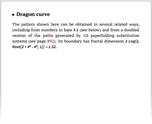
![Implementation [of geometric substitution systems] Implementation [of geometric substitution systems]](/nks/img/thumbnails/notes-5-4--implementation-of-geometric-substitution-systems--textonly.png)
![Connection [of geometric substitution systems] with digit sequences Connection [of geometric substitution systems] with digit sequences](/nks/img/thumbnails/notes-5-4--connection-of-geometric-substitution-systems-with-digit-sequences--textonly.png)
![Visualization [of geometric substitution systems] Visualization [of geometric substitution systems]](/nks/img/thumbnails/notes-5-4--visualization-of-geometric-substitution-systems--textonly.png)






![Neighbor-dependent [2D] substitution systems Neighbor-dependent [2D] substitution systems](/nks/img/thumbnails/notes-5-4--neighbor-dependent-2d-substitution-systems--textonly.png)

![Implementation [of network systems] Implementation [of network systems]](/nks/img/thumbnails/notes-5-5--implementation-of-network-systems--textonly.png)
![Rule structure [for network systems] Rule structure [for network systems]](/nks/img/thumbnails/notes-5-5--rule-structure-for-network-systems--textonly.png)
![[Systems based on] undirected networks [Systems based on] undirected networks](/nks/img/thumbnails/notes-5-5--systems-based-on-undirected-networks--textonly.png)
![Computer science [and network systems] Computer science [and network systems]](/nks/img/thumbnails/notes-5-5--computer-science-and-network-systems--textonly.png)
![Properties [of network systems] Properties [of network systems]](/nks/img/thumbnails/notes-5-5--properties-of-network-systems--textonly.png)



![Implementation [of network cellular automata] Implementation [of network cellular automata]](/nks/img/thumbnails/notes-5-5--implementation-of-network-cellular-automata--textonly.png)

![Implementation [of multiway systems] Implementation [of multiway systems]](/nks/img/thumbnails/notes-5-6--implementation-of-multiway-systems--textonly.png)
![General properties [of multiway systems] General properties [of multiway systems]](/nks/img/thumbnails/notes-5-6--general-properties-of-multiway-systems--textonly.png)
![Properties [of multiway system example] Properties [of multiway system example]](/nks/img/thumbnails/notes-5-6--properties-of-multiway-system-example--textonly.png)
![Frequency of behavior [in multiway systems] Frequency of behavior [in multiway systems]](/nks/img/thumbnails/notes-5-6--frequency-of-behavior-in-multiway-systems--textonly.png)
![History [of multiway systems] History [of multiway systems]](/nks/img/thumbnails/notes-5-6--history-of-multiway-systems--textonly.png)
![Semigroups and groups [and multiway systems] Semigroups and groups [and multiway systems]](/nks/img/thumbnails/notes-5-6--semigroups-and-groups-and-multiway-systems--textonly.png)
![Formal languages [and multiway systems] Formal languages [and multiway systems]](/nks/img/thumbnails/notes-5-6--formal-languages-and-multiway-systems--textonly.png)

![Limited size versions [of multiway systems] Limited size versions [of multiway systems]](/nks/img/thumbnails/notes-5-6--limited-size-versions-of-multiway-systems--textonly.png)



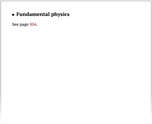

![The notion of equations [versus constraints] The notion of equations [versus constraints]](/nks/img/thumbnails/notes-5-7--the-notion-of-equations-versus-constraints--textonly.png)


![1D [systems based on] constraints 1D [systems based on] constraints](/nks/img/thumbnails/notes-5-7--1d-systems-based-on-constraints--textonly.png)

![[Excluded blocks in] dynamical systems theory [Excluded blocks in] dynamical systems theory](/nks/img/thumbnails/notes-5-7--excluded-blocks-in-dynamical-systems-theory--textonly.png)
![2D [systems based on] constraints 2D [systems based on] constraints](/nks/img/thumbnails/notes-5-7--2d-systems-based-on-constraints--textonly.png)
![Numbering scheme [for 2D constraints] Numbering scheme [for 2D constraints]](/nks/img/thumbnails/notes-5-7--numbering-scheme-for-2d-constraints--textonly.png)
![Identifying the 171 patterns [that satisfy 2D constraints] Identifying the 171 patterns [that satisfy 2D constraints]](/nks/img/thumbnails/notes-5-7--identifying-the-171-patterns-that-satisfy-2d-constraints--textonly.png)
![Checking [tilings with] constraints Checking [tilings with] constraints](/nks/img/thumbnails/notes-5-7--checking-tilings-with-constraints--textonly.png)
![Representing repetitive [2D] patterns Representing repetitive [2D] patterns](/nks/img/thumbnails/notes-5-7--representing-repetitive-2d-patterns--textonly.png)
![Searching for patterns [that satisfy constraints] Searching for patterns [that satisfy constraints]](/nks/img/thumbnails/notes-5-7--searching-for-patterns-that-satisfy-constraints--textonly.png)
![Undecidability [for 2D constraints] Undecidability [for 2D constraints]](/nks/img/thumbnails/notes-5-7--undecidability-for-2d-constraints--textonly.png)
![NP completeness [for 2D constraints] NP completeness [for 2D constraints]](/nks/img/thumbnails/notes-5-7--np-completeness-for-2d-constraints--textonly.png)

![Non-periodic pattern [forced by 2D constraint] Non-periodic pattern [forced by 2D constraint]](/nks/img/thumbnails/notes-5-7--non-periodic-pattern-forced-by-2d-constraint--textonly.png)
![Other types of [2D] constraints Other types of [2D] constraints](/nks/img/thumbnails/notes-5-7--other-types-of-2d-constraints--textonly.png)
![Forcing nested [2D] patterns Forcing nested [2D] patterns](/nks/img/thumbnails/notes-5-7--forcing-nested-2d-patterns--textonly.png)


![Non-computable [2D] patterns Non-computable [2D] patterns](/nks/img/thumbnails/notes-5-7--non-computable-2d-patterns--textonly.png)
![Tiling [problems] Tiling [problems]](/nks/img/thumbnails/notes-5-7--tiling-problems--textonly.png)


![Correspondence systems [as constraints] Correspondence systems [as constraints]](/nks/img/thumbnails/notes-5-7--correspondence-systems-as-constraints--textonly.png)
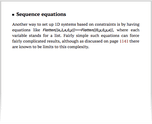

![Formal languages [and constraints] Formal languages [and constraints]](/nks/img/thumbnails/notes-5-7--formal-languages-and-constraints--textonly.png)


